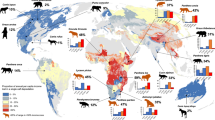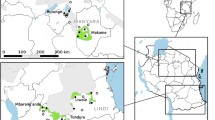Abstract.
There is growing interest in assessing how income influences the consumption of wildlife in poor rural areas of developing nations. The interest stems from the possibility of using income to contribute to the conservation of wildlife. Though promising, efforts have been hampered by the difficulty of obtaining accurate measures of income. We propose using human body-mass index (BMI: weight in kilograms/physical stature in m2), an indicator of short-term nutritional status, as a proxy variable for monetary income to estimate income elasticities of wildlife consumption (income elasticity: percent change in wildlife consumption/one-percent change income). The advantages of BMI over monetary income include a positive association with monetary income, ease of measurement, and absence of zero values. The assessment procedure was tested among Tsimane’ Amerindians, a society of foragers and farmers in the Bolivian Amazon. The population over 15 years of age (350 men and 322 women) in 13 villages was surveyed for five consecutive quarters (August 2002–November 2003). Income elasticities of wildlife consumption using BMI as a proxy for income ranged from −0.84 to −1.20. The estimates suggest that wildlife is a food item whose consumption declines with increasing income. Estimates of income elasticity of wildlife consumption using conventional indices of monetary income are negative, but lower and indistinguishable from zero owing to classical measurement errors of monetary income. The use of BMI to estimate income elasticities of wildlife consumption is promising, but requires further validation in different settings.
Similar content being viewed by others
References
Alderman H., Hoddinott J. and Kinsey B. 2003. Long-term Consequences of Early Childhood Malnutrition. Washington, D.C., IFPRI, Food Consumption and Nutrition Division Working Paper 68.
Angrist J.D. and Krueger A.B. (1999). Empirical strategies in labor economics. In: Ashenfelter, O. and Card, D. (eds) Handbook of Labor Economics, pp 1277–1366. Elsevier Science, Amsterdam
Apaza L. (2001). Uso de mamíferos entre los Tsimane’. Department of Biology, Universidad Mayor de San Andrés, La Paz, Bolivia
Apaza L., Godoy R.A., Wilkie D.S., Byron E., Huanca T., Leonard W.R., Pérez E., Vadez V. and Reyes-García V. (2003). Markets and the use of wild animals for traditional medicine: a case study among the Tsimane’ Amerindians of the Bolivian rain forest. J. Ethnobiol. 23: 47–64
Apaza L., Wilkie D.S., Byron E., Huanca T., Leonard W.R., Perez E., Reyes-García V., Vadez V. and Godoy R.A. (2002). Role of meat prices in household consumption of bushmeat among the Tsimane’ Amerindians of Bolivia. Onyx 36: 382–388
Byron E. (2003). Markets and health: the impact of markets on the nutritional status, morbidity and diet of the Tsimane’ Amerindians of lowland Bolivia. Department of Anthropology, University of Florida, Gainesville, Florida
Daillant I. (1994). Sens dessus-dissous. Organisation sociale et spatial des Chimanes d’Amazonie boliviene. Laboratoire d’ethnologie et de Sociologie Comparative, Université de Paris, Paris
Deaton A. (1997). The Analysis of Household Surveys: A Micro-econometric Approach to Development Policy. Johns Hopkins University Press, Baltimore, Maryland
Demmer J., Godoy R., Wilkie D. and Overman H. (2002). Do levels of income explain differences in game abundance? An empirical test in two Honduran villages. Biodivers. Conserv. 11: 1845–1868
Demmer J. and Overman H. (2001). Indigenous People Conserving the Rain Forest? The Effect of Wealth and Markets on the Economic Behavior of Tawahka Amerindians in Honduras. TROPENBOS, Amsterdam
Ellis R. (1996). A taste for movement: an exploration of the social ethics of the Tsimanes of lowland Bolivia. Department of Anthropology, St. Andrews University, Scotland
Fogel R.W. (1994). Economic growthpopulation theory and physiology: the bearing of long-term processes on the making of economic policy. Am. Econ. Rev. 84: 369–394
Foster Z., Byron E., Reyes-García V., Huanca T., Vadez V., Apaza L., Pérez E., Tanner S., Gutierrez Y., Sandstrom B., Yakhedts A., Osborn C., Godoy R. and Leonard W.R. (2005). Physical growth and nutritional status of Tsimane’ Amerindian children of lowland Bolivia. Am. J. Phys. Anthropol. 126: 343–51
Fowler F.J. (2001). Survey Research Methods. Sage Publications, Newbury Park, California
Friedman M. (1957). A Theory of the Consumption Function. Princeton University Press, Princeton, New Jersey
Godoy R.A. (2001). Indians, Markets and Rain Forests: Theory, Methods, Analysis. Columbia University Press, New York
Godoy R.A. and Lubowski R.N. (1992). Guidelines for economic valuation of non-timber tropical-forest products. Curr. Anthropol. 33: 423–433
Godoy R.A., Wilkie D.S., Overman H., Demmer J., Cubas A., McSweeney K. and Brokaw N. (2000). Valuation of consumption and sale of forest goods from a Central American rain forest. Nature 406: 62–63
Godoy R.A., Karlan D.S., Rabindran S. and Huanca T. (2004). Do modern forms of human capital matter in primitive economies? Comparative evidence from Bolivia. Econ. Educ. Rev. 24: 45–53
Godoy R.A., Overman H., Demmer J., Apaza L., Byron E., Huanca T., Leonard W., Pérez E., Reyes-García V., Vadez V., Wilkie D., McSweeney K., Cubas A. and Brokaw N. (2002). Local financial benefits of rain forests: comparative evidence from Amerindian society in Bolivia and Honduras. Ecol. Econ. 40: 397–409
Huanca T. (1999). Tsimane’ indigenous knowledgeswidden fallow managementand conservation. Department of Anthropology, University of Florida, Gainesville, Florida
Instituto Nacional de Estadística. (2003). Bolivia: Caracteristicas sociodemográficas de la población indigena. INE, La Paz
Komlos J. (1994). StatureLiving Standards and Economic Development. The University of Chicago Press, Chicago
Lohman T.G., Roche A.F. and Martorell R. (1988). Anthropometric Standardization Reference Manual (Abridged Edition). Human Kinetics Publishers, Windsor, Ontario
McDade T.W., Leonard W.R., Burhop J., Reyes-Garcia V., Vadez V., Huanca T. and Godoy R.A. 2005. Predictors of C-reactive protein in Tsimane’ 2ΓÇô15┬áyear-olds in lowland Bolivia. Am. J. Phys. Anthropol. In press.
Pérez E. (2001). Uso de la ictiofauna por dos comunidades Tsimane’: San Antonio y Yaranda (T.I. Tsimane’, Depto. Beni) bajo diferente influencia del mercado. B.S. Thesis. Department of Biology, Universidad Mayor de San Andrés, La Paz, Bolivia
Reyes-García V. (2001). Indigenous peopleethnobotanical knowledgeand market economy: a case study of the Tsimane’ Amerindians in lowland Bolivia. Department of Anthropology, University of Florida, Gainesville, Florida
Steckel R.H. (1995). Stature and the standard of living. J. Econ. Lit. 33: 1903–1940
Steckel R.H. (2003). What can be learned from skeletons that might interest economists, historians and other social scientists?. Am. Econ. Rev. Papers Proc. 93: 213–220
Strauss J. and Thomas D. (1998). Healthnutrition and economic development. J. Econ. Lit. 36: 766–817
Tanner S. (2005). A population in transition: healthculture changeand intestinal parasitism among the Tsimane’ of lowland Bolivia. Department of Anthropology, University of Michigan, Ann Arbor, Michigan
Vadez V., Reyes-García V., Godoy R.A., Apaza L., Byron E., Huanca T., Leonard W.R., Wilkie D. and Perez E. (2004). Does integration to the market threaten agricultural diversity? Panel and cross-sectional evidence from a horticultural-foraging society in the Bolivian Amazon. Hum. Ecol. 32: 635–646
Wilkie D.S. and Godoy R.A. (2001). Income and price elasticities of bushmeat demand in lowland Amerindian societies. Conserv. Biol. 15: 1–9
Wilkie D.S., Starkey M., Abernethy K., Nstame Effa E., Telfer P. and Godoy R.A. (2005). Role of prices and wealth in consumer demand for bushmeat in Gabon, Central Africa. Conserv. Biol. 19: 1–7
Author information
Authors and Affiliations
Corresponding author
Rights and permissions
About this article
Cite this article
Godoy, R., Wilkie, D.S., Reyes-García, V. et al. Human Body-mass Index (Weight in kg/stature in m2) as a Useful Proxy to Assess the Relation between Income and Wildlife Consumption in Poor Rural Societies. Biodivers Conserv 15, 4495–4506 (2006). https://doi.org/10.1007/s10531-005-5100-y
Received:
Accepted:
Published:
Issue Date:
DOI: https://doi.org/10.1007/s10531-005-5100-y




